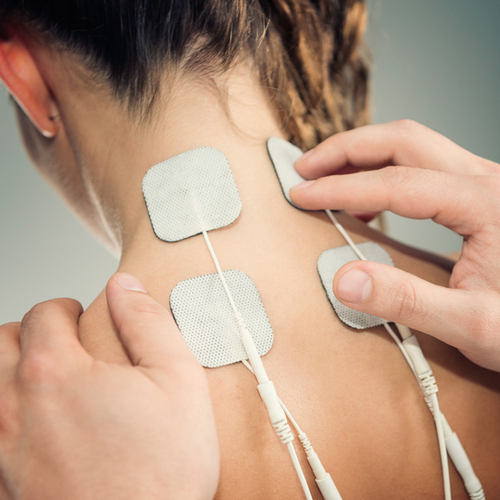
Transcutaneous electrical acustimulation
Alternate names: Acupoint Electrical Stimulation, Acupoint Stimulation, Acupuncture Point Stimulation, Acupuncture-like Transcutaneous Electrical Nerve Stimulation, AcuTENS, Percutaneous Acupoint Electrical Stimulation, TEAS, Transcutaneous Acupoint Electrical Stimulation, Transcutaneous Electrical Acupoint Stimulation
Background
Transcutaneous electrical acustimulation involves applying a low-intensity electrical current to acupuncture points without puncturing the skin.
Acustimulation is different from electroacupuncture, which uses needles that puncture the skin. It is also different than transcutaneous electrical nerve stimulation (TENS). TENS doesn't use acupuncture points (acupoints). According to traditional Chinese medicine, stimulating acupoints helps balance specific organs, emotions, and feelings.
People use acustimulation for nausea and vomiting or pain after surgery. It's also used for motion sickness, alcohol use disorder, neck pain, and many other conditions, but there is no good scientific evidence to support most of these other uses.
Don't confuse acustimulation with Traditional Chinese Medicine, Kampo Medicine, acupressure, acupuncture, moxibustion, or trigger point therapy. These are not the same.
Acustimulation is different from electroacupuncture, which uses needles that puncture the skin. It is also different than transcutaneous electrical nerve stimulation (TENS). TENS doesn't use acupuncture points (acupoints). According to traditional Chinese medicine, stimulating acupoints helps balance specific organs, emotions, and feelings.
People use acustimulation for nausea and vomiting or pain after surgery. It's also used for motion sickness, alcohol use disorder, neck pain, and many other conditions, but there is no good scientific evidence to support most of these other uses.
Don't confuse acustimulation with Traditional Chinese Medicine, Kampo Medicine, acupressure, acupuncture, moxibustion, or trigger point therapy. These are not the same.
Safety Safety definitions
Acustimulation is likely safe when used appropriately, short-term. No serious side effects have been reported. The most common acustimulation device is the ReliefBand. This device is approved by the US FDA. Other devices have also been used safely.
Special Precautions & Warnings:
Pregnancy and breast-feeding: There isn't enough reliable information to know if acustimulation is safe to use when pregnant or breast-feeding. But there's no reason to expect safety concerns when used appropriately.Effectiveness
NatMed Pro rates effectiveness based on scientific evidence according to the following scale: Effective, Likely Effective, Possibly Effective, Possibly Ineffective, Likely Ineffective, Ineffective, and Insufficient Evidence to Rate.
Possibly effective Effectiveness definitions
- A decline in memory and thinking skills (cognitive function) after surgery. Acustimulation seems to help prevent a decline in cognitive function after surgery.
- Impaired movement of food through the intestines after surgery. Acustimulation seems to encourage normal bowel functions and prevents problems with bowel functions after surgery.
- Nausea and vomiting after surgery. Acustimulation seems to help prevent nausea and vomiting after surgery, although it's not clear if it's more helpful than antinausea drugs alone. It's also not clear if acustimulation helps to treat nausea and vomiting.
- Pain after surgery. Acustimulation seems to help reduce pain after surgery in most people.
Possibly ineffective Effectiveness definitions
- Nausea and vomiting caused by cancer drug treatment. Acustimulation doesn't seem to help reduce nausea and vomiting caused by cancer drugs.
Dosing & administration
Acustimulation is given using electrodes attached to specific points (acupoints) on the body. Small electric currents are administered to these acupoints. Various devices are used, such as the ReliefBand. The ReliefBand is worn on the wrist like a watch. It applies a small electric current to an acupoint on the wrist. Talk to your physician or other healthcare professional to learn more about how acustimulation is used for specific conditions.
Interactions with pharmaceuticals
It is not known if this treatment interacts with any medicines. Before using this treatment, talk with your health professional if you take any medications.
Interactions with herbs & supplements
There are no known interactions with herbs and supplements.
Interactions with foods
There are no known interactions with foods.
vital.ly has licensed monographs from TRC Healthcare.
This monograph was last reviewed on 07/04/2025 10:00:00. Monographs are reviewed and/or updated multiple times per month and at least once per year.
Natural Medicines disclaims any responsibility related to medical consequences of using any medical product. Effort is made to ensure that the information contained in this monograph is accurate at the time it was published. Consumers and medical professionals who consult this monograph are cautioned that any medical or product related decision is the sole responsibility of the consumer and/or the health care professional. A legal License Agreement sets limitations on downloading, storing, or printing content from this Database. No reproduction of this monograph or any content from this Database is permitted without written permission from the publisher. It is unlawful to download, store, or distribute content from this site.




